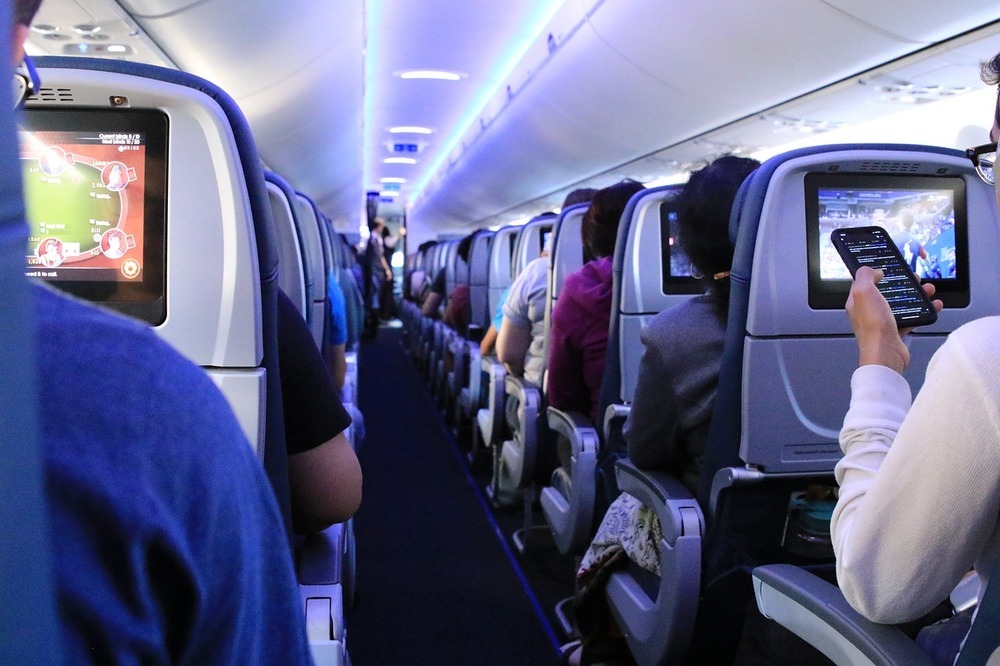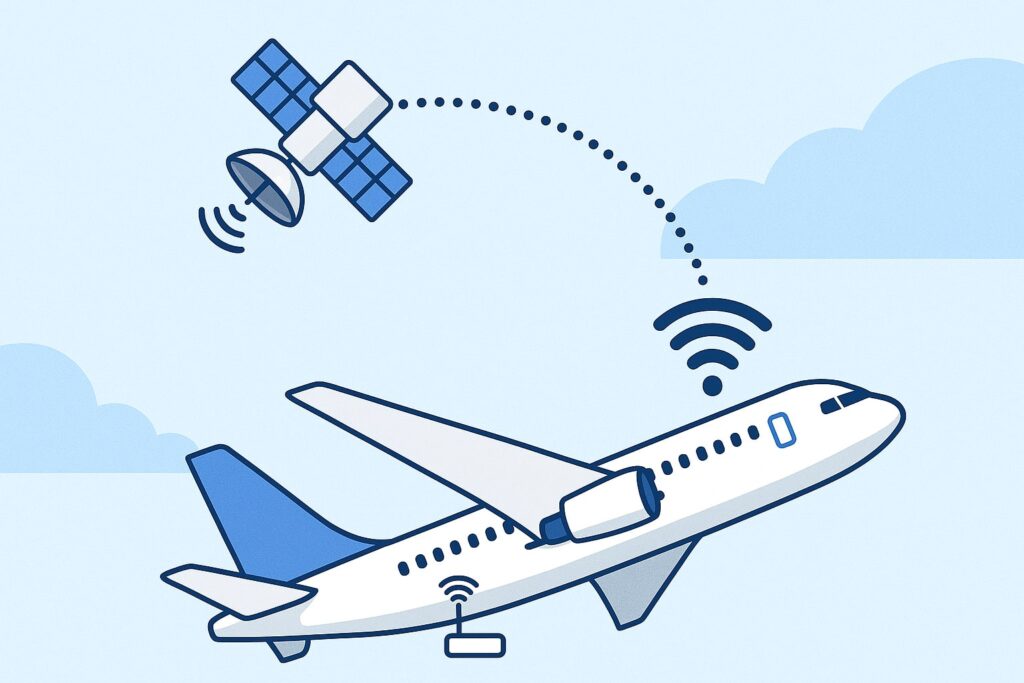Can you fire off a quick “landed safely” text while soaring 35,000 feet in the air? The answer depends on more than just your phone signal. With airplane mode mandatory and cellular networks out of reach, traditional texting isn’t an option—but that doesn’t mean you’re completely cut off.
In this guide, we’ll unpack the rules around texting on planes, the role of in-flight WiFi, and what you can (and can’t) do with your phone in the sky. Whether you’re trying to stay connected or avoid surprise charges, here’s everything you need to know before sending that mid-flight message.

Regulations Around Texting on a Plane
The regulations around the ability to use a cellular device in-flight are laid down by the Federal Aviation Administration (FAA) and the Federal Communications Commission (FCC).
FAA Regulations
The FAA, for instance, is responsible for the safety of civil aviation in all aspects. As a result, the many rules you come across in-flight, such as keeping your seats upright, turning on Airplane Mode, and folding away your tray tables during take-off and landing are all laid down by the FAA.
The primary reason behind the insistence on the use of Airplane Mode is to prevent cellular devices from interfering with an aircraft’s communication systems. Such interference can be a major risk to the flight’s safety, and this is where some airlines provide WiFI on board as an alternative. Some examples of airlines that provide WiFI include Alaska Airlines and United Airlines.
FCC Regulations
The FCC, on the other hand, regulates communications across states and nations. The primary reason behind the regulations surrounding the use of cellular devices is that they might interfere with communications on the ground. This is why the FCC has, for years, opposed the use of mobile devices, particularly keeping them connected to the cellular network.
However, according to Jackson Eckhoff, the CEO of BusinessClass.com, this perceived interference is no longer an issue. He states that “cell phones interfering with airplane operations is largely a myth. While older planes had concerns about radio interference, modern aircraft are designed with shielding to prevent electronic interference.”
Technology Behind Texting on Planes

Here are some key technologies that play a role in regulating the use of cellular networks on board an airplane.
Airplane Mode Requirement
Every time you’re on a flight, you would’ve heard the crew asking you to turn Airplane Mode on. What is its key purpose though? Airplane Mode is a feature available on all modern phones that disconnects it from the device’s cellular data, radio signals, and in several cases, even its WiFi and Bluetooth.
While one reason for the use of this mode is to prevent potential or perceived interference with the airplane’s communications, it also helps save your device’s battery. This is because your device is highly unlikely to get a signal of more than 30,000 feet in the air from any cell phone tower whatsoever. However, this doesn’t stop your device from continuously searching for a signal, a process that can quickly drain its battery.
This can be a major benefit, as passengers would land at an airport earlier, only to find their battery dead when they wanted to book themselves a taxi. Now, you can continue to use the media files on your device but importantly, prevent the major battery drain that occurs when it searches for cellular networks.
Cellular Network Restrictions
You now know that the altitude an airplane flies at often prevents it from connecting to cellular networks, making the use of Airplane Mode critical. However, there are two key technologies that help connect to a network, and which one works better depends on what kind of regions the airplane is flying over.
The first is air-to-ground connectivity, which relies on terrestrial cell phone towers to provide airplanes access to the internet. This technology offers good speeds when an airplane is within the tower’s range, but these speeds often drop when flying over oceans and remote areas.
On the other hand, satellite connectivity offers wider access to the internet, but can be slower in terms of speed and have higher latency.
In-Flight WiFi
It is because of these restrictions that several airlines now offer in-flight WiFi. As mentioned earlier, this allows you to send messages via social media, browse the internet, and consume content online. However, it has its fair share of drawbacks too. For starters, depending on which airline you’re flying with, you may not even have the benefit of in-flight WiFi. This is particularly the case with low-cost or budget airlines.
On the other hand, even on flights that offer WiFi, the speeds may not be as fast as they are on the ground, and this can affect how seamlessly you communicate with others.
Costs of Texting on a Plane
Among the airlines that do offer in-flight WiFi, the charges for this service vary. Take the example of United Airlines, for instance. The cost of in-flight WiFi is typically $10, but MileagePlus members can enjoy a lower price of $8.
United Airlines also offers a WiFi Day Pass if you don’t want to purchase WiFi for a single flight, or even a monthly pass for those who travel often. Prices for monthly subscriptions start at $49. While connectivity is a major concern for travelers, another common worry is lost baggage. If you’re concerned about luggage issues while traveling, understanding how often airlines lose luggage and how to retrieve it can help you prepare for potential inconveniences.
Another example is that of Alaska Airlines, which offers Satellite WiFi which is quick enough for you to stream on platforms like Hulu and Netflix, and a Basic Plan that’s best for checking your emails and performing tasks that require lower bandwidth. The cost of Basic WiFi can vary from $8 on an E175 aircraft to about $24.99 on a 737.
However, if you’re a T-Mobile user, you can enjoy free WiFi with Alaska and Delta Airlines each time you fly. On Alaska Airlines, for instance, you’ll get unlimited free sessions or four free full-flight sessions and unlimited 60-minute sessions.
Can You Text on a Plane Without WiFi?
The short answer is, no, you cannot text on a plane without WiFi. While some apps allow you to queue your texts so they can automatically be sent once your phone gains access to a cellular network, this isn’t instantaneous. If connectivity issues prevent you from receiving real-time updates, it could lead to missing important flight notifications. However, if you’re only concerned with ensuring your message isn’t left unsent, it can be a worthy option. In cases where a delay or miscommunication causes you to miss your next flight, knowing what happens if you miss a connecting flight can help you navigate the situation effectively.
While you can also text on the plane before it takes off, getting a signal of more than 30,000 feet in the air becomes close to impossible. This is where in-flight WiFi services come in handy.
How to Stay Connected While Flying
- Download Messaging Apps That Work Offline – Apps like WhatsApp, Telegram, and iMessage allow you to type and queue messages offline. Once your phone connects to WiFi or a network after landing, your messages will automatically send.
- Enable Offline Features for Essential Apps – Download Google Maps offline, save flight details in Google Keep or Notes, and enable email offline mode for Gmail so you can compose emails without a connection.
- Use Airline-Specific Messaging Services – Some airlines like Delta and Alaska Airlines allow free in-flight texting via iMessage, WhatsApp, and Facebook Messenger even without purchasing full WiFi access.
- Take Screenshots of Important Information – Before boarding, screenshot your boarding pass, hotel reservation, and transportation details so you can access them even if WiFi is unavailable.
Pro Tip: Always fully charge your phone before flying and carry a portable charger in case in-seat power outlets aren’t available.
Conclusion
In summary, it isn’t possible for you to text on a flight using a traditional cellular connection. The use of Airplane Mode prevents your phone from connecting to a cellular network, and the unavailability of the network mid-air makes the process impossible.
However, texting on an airplane is possible if your flight offers WiFi in-flight, or if you have paid for the service. Depending on what kind of subscription you get, you can use the WiFi to stream content on platforms like Netflix or perform more basic functions such as responding to emails and sending texts. In short, you can text on Airplane Mode with WiFi.
FAQ
Yes, you can text on a plane using the in-flight WiFi or using any airline-specific messaging platform.
While most apps require the use of WiFi to send texts, some airlines do offer services that let you do so without WiFi. However, given the altitude, you won’t have access to the regular cellular network.
Different airlines have different policies with regard to in-flight WiFi. While some might offer it for free, others will require you to pay for it. However, if your airline has a partnership with a cellular network provider (such as Alaska Airlines and T-Mobile), you can benefit from free WiFi.
Most airlines restrict the ability to make voice calls on an airplane to maintain a quiet and peaceful environment for other passengers. However, if the airline’s in-flight WiFi allows you to do so, you should be able to make voice calls.
The key reason why some airlines offer SMS but restrict media is that text messages require less data when compared to media files like photos and videos.
